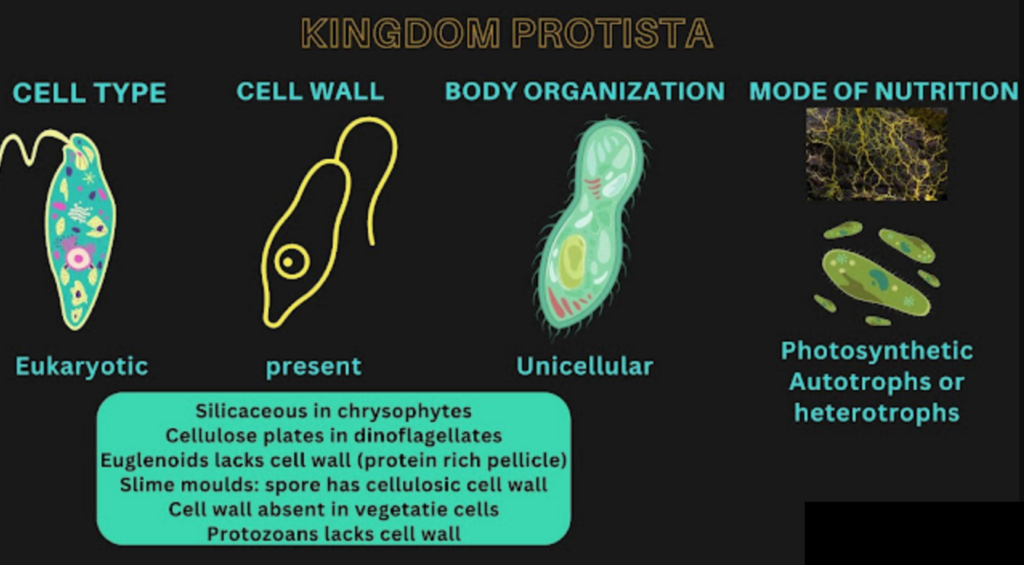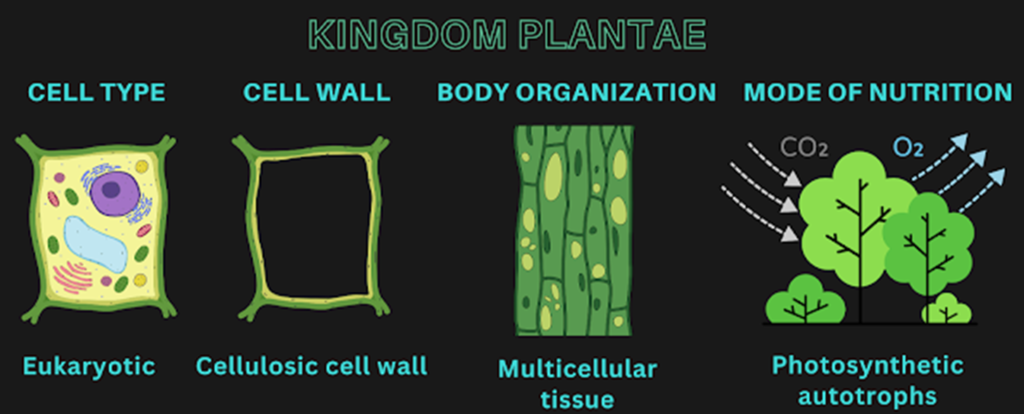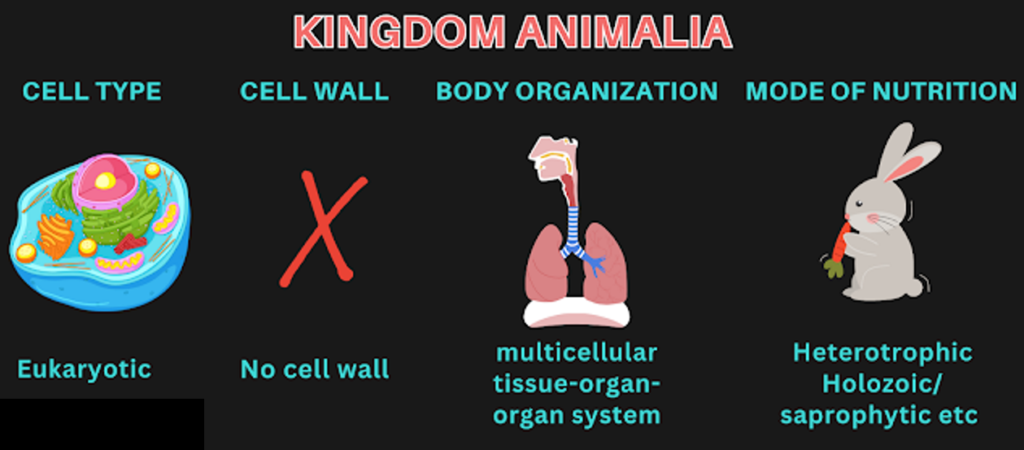The Five Kingdoms of Life classification of living organisms is essential for understanding biodiversity, evolution, and ecological relationships. Traditionally, organisms were classified into two kingdoms: Plantae (plants) and Animalia (animals). However, this system was inadequate to accommodate microorganisms and other unique life forms, leading to the development of more comprehensive classification systems.
In 1969, Robert H. Whittaker proposed the Five Kingdom Classification, which is widely accepted today. This system classifies organisms into five kingdoms based on characteristics like cell structure, mode of nutrition, body organization, and reproduction.
Five Kingdoms of Life
The five kingdoms are:
1. Monera (Bacteria)
2. Protista (Single-celled Eukaryotes)
3. Fungi (Molds, Yeasts, Mushrooms)
4. Plantae (Plants)
5. Animalia (Animals)
Basis of Classification
Whittaker classified organisms into five kingdoms based on the following criteria:
1. Cell Type – Prokaryotic or Eukaryotic.
2. Cell Structure – Presence of a cell wall, membrane composition, unicellular or multicellular.
3. Mode of Nutrition – Autotrophic (photosynthesis) or Heterotrophic (ingestion, absorption).
4. Reproduction – Asexual or Sexual.
5. Body Organization – Simple (unicellular) or Complex (tissue/organ level).
Explanation of the Five Kingdoms
1. Kingdom Monera (Prokaryotes – Bacteria & Archaea)
Kingdom Monera includes prokaryotic organisms, primarily bacteria and archaea, which are the simplest and oldest forms of life. These organisms lack a well-defined nucleus and membrane-bound organelles, with genetic material present in a single circular DNA molecule. Monerans are unicellular, though some may form colonies or filaments. They exhibit diverse modes of nutrition, including autotrophic (photosynthetic or chemosynthetic) and heterotrophic (saprophytic, parasitic, or symbiotic). Reproduction primarily occurs through binary fission, but genetic recombination can occur via conjugation, transformation, or transduction. Monerans play crucial roles in ecosystems, including nitrogen fixation, decomposition, and disease causation. Examples include Escherichia coli, Streptococcus, and Cyanobacteria (blue-green algae).
Characteristics:
- Unicellular and Prokaryotic (no membrane-bound organelles).
- No nucleus; instead, genetic material is in the nucleoid region.
- Cell wall present (made of peptidoglycan in bacteria).
- Mode of nutrition: Autotrophic (chemosynthetic/photosynthetic) or Heterotrophic (saprophytic/parasitic).
- Reproduce asexually by binary fission.
- Can be found in extreme environments (hot springs, acidic lakes, deep-sea vents).
Examples:
Escherichia coli (E. coli) – Found in intestines.
Streptococcus – Causes throat infections.
Cyanobacteria (Anabaena, Nostoc) – Photosynthetic bacteria.

2. Kingdom Protista (Eukaryotic Single-celled Organisms)
Kingdom Protista includes eukaryotic, mostly unicellular organisms that do not fit into the categories of plants, animals, or fungi. These organisms have a well-defined nucleus and membrane-bound organelles, making them more complex than Monerans. Protists exhibit diverse modes of nutrition, including autotrophic (photosynthetic, like Euglena and Diatoms) and heterotrophic (ingesting or absorbing food, like Amoeba and Paramecium). Some protists, like Plasmodium, are parasitic and cause diseases such as malaria. Reproduction occurs both asexually (binary fission, multiple fission) and sexually (conjugation or gamete formation). Protists inhabit aquatic environments, moist soils, and host organisms, playing crucial roles in ecological balance, including oxygen production and nutrient recycling.
Characteristics:
- Unicellular eukaryotes (have a nucleus and membrane-bound organelles).
- Cell wall is present in some (e.g., algae) but absent in others (e.g., protozoa).
- Mode of nutrition:
Autotrophic (photosynthetic, like Euglena).
Heterotrophic (ingest food, like Amoeba).
- Reproduce sexually and asexually (binary fission, multiple fission, conjugation).
Examples:
Amoeba – Moves using pseudopodia.
Paramecium – Moves using cilia.
Plasmodium – Causes malaria.
Euglena – Has both plant and animal-like characteristics.

3. Kingdom Fungi (Molds, Mushrooms, Yeasts)
Kingdom Fungi consists of eukaryotic, heterotrophic organisms that primarily obtain nutrients through absorption. Unlike plants, fungi lack chlorophyll and cannot perform photosynthesis. Their cell walls are made of chitin instead of cellulose. Fungi exist in various forms, including unicellular (yeasts) and multicellular (molds and mushrooms). They reproduce both sexually and asexually through spores, budding, or fragmentation. Fungi play essential ecological roles as decomposers, breaking down organic matter and recycling nutrients. Some fungi form symbiotic relationships, such as mycorrhizae with plant roots. While many fungi are beneficial (Penicillium produces antibiotics), others can be harmful, causing infections like athlete’s foot (Trichophyton) and crop diseases (Puccinia).
Characteristics:
- Eukaryotic, mostly multicellular (except yeast, which is unicellular).
- Cell wall made of chitin (not cellulose, like in plants).
- Heterotrophic (absorb nutrients from dead or decaying matter – saprophytic, parasitic, or mutualistic).
- Reproduce by spores (asexually or sexually).
- Lack chlorophyll and cannot perform photosynthesis.
Examples:
Rhizopus (bread mold).
Aspergillus (produces antibiotics).
Saccharomyces (yeast, used in baking and fermentation).
Agaricus (mushroom).

4. Kingdom Plantae (Plants)
Kingdom Plantae includes multicellular, eukaryotic, autotrophic organisms that perform photosynthesis using chlorophyll. Plants have cell walls made of cellulose and store energy primarily as starch. They are classified into different groups based on their structural complexity and reproductive methods, including Thallophyta (algae), Bryophyta (mosses, liverworts), Pteridophyta (ferns), Gymnosperms (cone-bearing plants), and Angiosperms (flowering plants). Most plants reproduce sexually through seeds or spores, though some also propagate asexually (e.g., vegetative propagation in potatoes). Plants are essential for life on Earth, producing oxygen, providing food, and maintaining ecological balance. They also have medicinal, industrial, and economic importance.
Characteristics:
- Eukaryotic and multicellular.
- Cell wall present (made of cellulose).
- Autotrophic (photosynthetic) – Contains chlorophyll for photosynthesis.
- Reproduction:
Asexual (vegetative propagation, spores).
Sexual (flowering plants).
- Well-defined tissues and organs (roots, stems, leaves, flowers).
Examples:
Hibiscus (flowering plant).
Pinus (coniferous plant).
Mango tree (Mangifera indica).
Fern (Pteris).

5. Kingdom Animalia (Animals)
Kingdom Animalia includes multicellular, eukaryotic, heterotrophic organisms that lack cell walls. Animals obtain energy by consuming organic matter and exhibit various modes of nutrition, including herbivory, carnivory, and omnivory. They possess specialized tissues and organ systems for functions such as movement, digestion, circulation, and reproduction. Most animals have a nervous system for responding to stimuli, and locomotion is a key characteristic in many species. Reproduction occurs sexually, with some animals also capable of asexual reproduction (e.g., budding in Hydra). Kingdom Animalia is classified into different phyla, including Porifera (sponges), Cnidaria (jellyfish, corals), Arthropoda (insects, crustaceans), Chordata (vertebrates like fish, birds, and mammals), and many more. Animals play essential roles in ecosystems, contributing to biodiversity, food chains, and ecological balance.
Characteristics:
- Eukaryotic and multicellular.
- No cell wall.
- Heterotrophic (ingest food).
- Highly developed nervous and sensory systems.
- Sexual reproduction is dominant.
- Locomotion (movement through muscles, limbs, fins, or wings).
Examples:
Homo sapiens (Humans).
Canis lupus (Dog).
Panthera leo (Lion).
Frog, Fish, Birds, Insects.

Comparison of Five Kingdoms
| Feature | Monera | Protista | Fungi | Plantae | Animalia |
| Cell Type | Prokaryotic | Eukaryotic | Eukaryotic | Eukaryotic | Eukaryotic |
| Number of Cells | Unicellular | Mostly Unicellular | Multicellular (except yeast) | Multicellular | Multicellular |
| Cell Wall | Present (Peptidoglycan) | Present in some | Present (Chitin) | Present (Cellulose) | Absent |
| Mode of Nutrition | Autotrophic & Heterotrophic | Autotrophic & Heterotrophic | Heterotrophic (saprophytic) | Autotrophic (photosynthesis) | Heterotrophic (ingestion) |
| Locomotion | Some move (flagella) | Some move (cilia, flagella) | Non-motile | Non-motile | Motile |
| Example | E. coli, Streptococcus | Amoeba, Euglena | Mushroom, Yeast | Mango tree, Fern | Humans, Dogs |
Significance of Five Kingdom Classification
1. More Scientific – Considers evolutionary relationships, cell structure, and function.
2. Recognizes Unique Groups – Bacteria, Protists, and Fungi get their own classification.
3. Universal Acceptance – Used globally for identifying and studying organisms.
4. Basis for Modern Taxonomy – Helps classify newly discovered species.
Conclusion
Whittaker’s Five Kingdom Classification remains one of the most comprehensive and widely accepted biological classification systems. It groups organisms based on their cell structure, mode of nutrition, and organization. This system has greatly contributed to understanding biodiversity and evolutionary relationships among different life forms.

